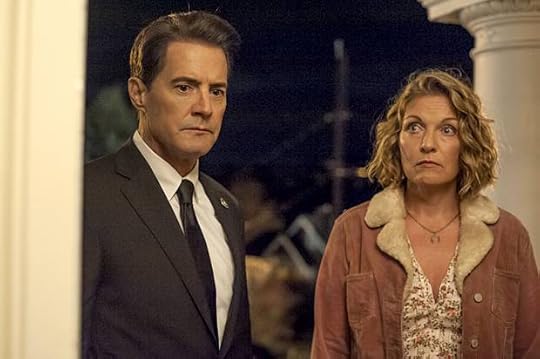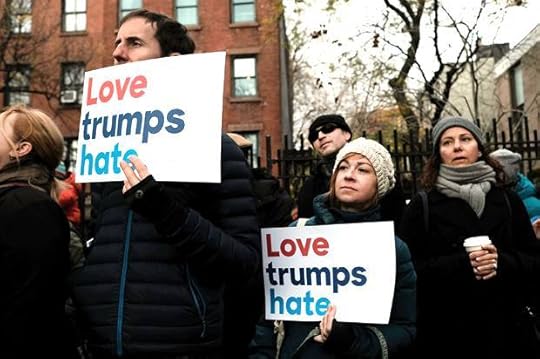Helen H. Moore's Blog, page 310
September 5, 2017
Revealing the mystery behind “Twin Peaks: The Return”’s new mysteries

Kyle MacLachlan and Sheryl Lee in Twin Peaks (Credit: Showtime/Suzanne Tenner)
I mean this in a value neutral sense: The finale of “Twin Peaks: The Return” was confounding. It was confounding because of the episodes that led up to it. and Mark Frost were on the verge of tying the various plot threads together — and they succeeded in doing so with some (killing Mr. C) — but instead they cast a few aside (What happened to Audrey Horne?) and tangled the ones they tied into something resembling an existential puzzle.
There are, and will be, plenty of theories about what happened — about what happens when characters cross dimensions, about the role of the Tremonds and Chalfonts and about whether Agent Cooper (or Richard?) and Carrie Page (or Laura Palmer?) are in the past or the future when they visit Laura’s old home in the final scene. But the only theories I’m interested in are the ones that explain why Lynch and Frost elected to end the show the way they did.
To recap the final episode: Cooper wakes up in the Black Lodge, finds a forest of barren trees beyond a curtain and is reunited with Diane. They drive through the desert, where they find a portal. They cross the portal, stay the night at a motel and have sex. In the morning, Cooper finds a goodbye note addressed to Richard (perhaps him), from someone named Linda (perhaps Diane). He picks up Carrie Page (a woman who he thinks is Laura Palmer) from Odessa and brings her to her childhood home in Twin Peaks. She doesn’t recognize the home at first and the Palmers don’t live there. But when Cooper asks, “What year is it?”, Carrie/Laura shudders and then screams.
The episode felt like a response to the one that came before it. The penultimate episode was dedicated to Agent Cooper killing evil (with help from Freddie Sykes and Lucy) and executing a plan to undo Laura Palmer’s death. In the finale, the universe seemed to respond with, “Things aren’t so simple.” Answers were followed by questions.
Plenty of shows have struggled with resolution but it’s hard to recall one that has bucked resolution like “The Return.” This was a show that had the end in sight from the beginning — Lynch compared making it to making an 18-hour movie — so we can assume that the ending was thought through, not some corner Lynch and Frost backed themselves into. There’s also no indication that Lynch and Frost were setting the stage for another season.
Instead, the new mysteries they unraveled seemed intended to haunt the viewer. It’s become a clichéd trope for characters on television and in the movies to find themselves in absurd or terrifying situations, only to wake up and realize it was all just a dream. In the penultimate episode, a large Cooper face superimposed behind Cooper says, in slow motion, “We live inside a dream,” a callback to a scene in “Fire Walk With Me.” The show, like Lynch’s other work, has always employed some degree of dream logic. But here, the point became especially pronounced: It wasn’t all just a dream; it is all just a dream.
But is the “we” living inside the dream humanity? The characters within the world that the show has always led us to believe is the real world? Or is it a meta commentary? Is the “dream” television?
There’s no right answer (unless Lynch says there is). But the show sure has a tendency to lodge itself in the viewer’s brain, much like a dream. It’s the sort of art that with time becomes indistinguishable: Did that happen, was it a dream, or did I see it on TV? The characters are living in a dream and the dream lives in us. When Cooper says “See you at the curtain call” in the penultimate episode, it seems like he’s talking to the viewer as much as he is talking to the characters on the show.
A kind of macabre metaness is woven throughout the season. In one episode, for instance, the Log Lady, played by Catherine Coulson, calls Hawk to tell him she is dying; by the time the episode aired Coulson herself had died. Other dead actors’ characters were reintroduced in new forms: David Bowie’s Phillip Jeffries as a tea kettle; Don S. Davis’s Maj. Garland Briggs as a floating head. And Cooper’s return mirrored the show’s: It took a while but when it happened it was initially exultant. There is space to interpret “The Return” as a commentary on returns.
So, could the show’s final episode have been addressed to fans as much as it was for them? In its final hour “Twin Peaks: The Return” sprouted out instead of looping back, suggesting the mysteries are continuous and the case is never closed. The “Twin Peaks” story will always be unfolding in some plane of existence, be it televisual or metaphysical.
Read Natalia Ginzburg’s “Winter in the Abruzzi”

(Credit: Getty/ffolas)
There are only two seasons in the Abruzzi: summer and winter. The spring is snowy and windy like the winter, and the autumn is hot and clear like the summer. Summer starts in June and ends in November. The long days of sunshine on the low, parched hills, the yellow dust in the streets and the babies’ dysentery come to an end, and winter begins. People stop living in the streets: the barefoot children disappear from the church steps. In the region I am talking about almost all the men disappeared after the last crops were brought in: they went for work to Terni, Sulmona or Rome. Many bricklayers came from that area, and some of the houses were elegantly built; they were like small villas with terraces and little columns, and when you entered them you would be astonished to find large dark kitchens with hams hanging from the ceilings, and vast, dirty, empty rooms. In the kitchen a fire would be burning, and there were various kinds of fire: there were great fires of oak logs, fires of branches and leaves, fires of twigs picked up one by one in the street. It was easier to tell the rich from the poor by looking at the fires they burnt than by looking at the houses or at the people themselves, or at their clothes and shoes which were all more or less the same.
![[Book Title]](https://i.gr-assets.com/images/S/compressed.photo.goodreads.com/hostedimages/1504703784i/23804768.jpg)
When I first arrived in that countryside all the faces looked the same to me, all the women—rich and poor, young and old—resembled one another. Almost all of them had toothless mouths: exhaustion and a wretched diet, the unremitting overwork of childbirth and breast feeding, mean that women lose their teeth there when they are thirty. But then, gradually, I began to distinguish Vincenzina from Secondina, Annunziata from Addolerata, and I began to go into their houses and warm myself at their various fires.
When the first snows began to fall a quiet sadness took hold of us. We were in exile: our city was a long way off, and so were books, friends, the various desultory events of a real existence. We lit our green stove with its long chimney that went through the ceiling: we gathered together in the room with the stove—there we cooked and ate, my husband wrote at the big oval table, the children covered the floor with toys. There was an eagle painted on the ceiling of the room, and I used to look at the eagle and think that was exile. Exile was the eagle, the murmur of the green stove, the vast, silent countryside and the motionless snow. At five o’clock the bell of the church of Santa Maria would ring and the women with their black shawls and red faces went to Benediction. Every evening my husband and I went for a walk: every evening we walked arm in arm, sinking our feet into the snow. The houses that ran alongside the street were lived in by people we knew and liked, and they all used to come to the door to greet us. Sometimes one would ask, ‘When will you go back to your own house?’ My husband answered, ‘When the war is over’. ‘And when will this war be over? You know everything and you’re a professor, when will it be over?’ They called my husband ‘the professor’ because they could not pronounce his name, and they came from a long way off to ask his advice on the most diverse things—the best season for having teeth out, the subsidies which the town-hall gave, and the different taxes and duties.
In winter when an old person died of pneumonia the bell of Santa Maria sounded the death knell and Domenico Orecchia, the joiner, made the coffin. A woman went mad and they took her to the lunatic asylum at Collemaggio, and this was the talk of the countryside for a while. She was a young, clean woman, the cleanest in the whole district; they said it was excessive cleanliness that had done it to her. Girl twins were born to Gigetto di Calcedonio who already had boy twins, and there was a row at the town-hall because the authorities did not want to give the family any help as they had quite a bit of land and an immense kitchen-garden. A neighbour spat in the eye of Rosa, the school caretaker, and she went about with her eye bandaged because she intended to pay back the insult. ‘The eye is a delicate thing, and spit is salty,’ she explained. And this was talked about for a while, until there was nothing else to say about it.
Every day homesickness grew in us. Sometimes it was even pleasant, like being in gentle slightly intoxicating company. Letters used to arrive from our city with news of marriages and deaths from which we were excluded. Sometimes our homesickness was sharp and bitter, and turned into hatred; then we hated Domenico Orecchia, Gigetto di Calcedonio, Annunziatina, the bells of Santa Maria. But it was a hatred which we kept hidden because we knew it was unjust; and our house was always full of people who came to ask for favours and to offer them. Sometimes the dressmaker made a special kind of dumpling for us. She would wrap a cloth round her waist and beat the eggs, and send Crocetta around the countryside to see if she could borrow a really big saucepan. Her red face was absorbed in her work and her eyes shone with a proud determination. She would have burnt the house down to make her dumplings come out a success. Her clothes and hair became white with flour and then she would place the dumplings with great care on the oval table where my husband wrote.
Crocetta was our serving woman. In fact she was not a woman because she was only fourteen years old. It was the dressmaker who had found her. The dressmaker divided the world into two groups—those who comb their hair and those who do not comb their hair. It was necessary to be on the lookout against those who do not comb their hair because, naturally, they have lice. Crocetta combed her hair; and so she came to work for us and tell our children long stories about death and cemeteries. Once upon a time there was a little boy whose mother died. His father chose another wife and this stepmother didn’t love the little boy. So she killed him when his father was out in the fields, and she boiled him in a stew. His father came home for supper, but, after he had finished eating, the bones that were left on the plate started to sing
Mummy with an angry frown
Popped me in the cooking pot,
When I was done and piping hot
Greedy daddy gulped me down.
Then the father killed his wife with a scythe and he hung her from a nail in front of the door. Sometimes I find myself murmuring the words of the song in the story, and then the whole country is in front of me again, together with the particular atmosphere of its seasons, its yellow gusting wind and the sound of its bells.
Every morning I went out with my children and there was a general amazed disapproval that I should expose them to the cold and the snow. ‘What sin have the poor creatures committed?’ people said. ‘This isn’t the time for walking, dear. Go back home.’ I went for long walks in the white deserted countryside, and the few people I met looked at the children with pity. ‘What sin have they committed?’ they said to me. There, if a baby is born in winter they do not take it out of the room until the summer comes. At midday my husband used to catch me up with the post and we went back to the house together.
I talked to the children about our city. They had been very small when we left, and had no memories of it at all. I told them that there the houses had many storeys, that there were so many houses and so many streets, and so many big fine shops. ‘But here there is Giro’s,’ the children said.
Giro’s shop was exactly opposite our house. Giro used to stand in the doorway like an old owl, gazing at the street with his round, indifferent eyes. He sold a bit of everything; groceries and candles, postcards, shoes and oranges. When the stock arrived and Giro unloaded the crates, boys ran to eat the rotten oranges that he threw away. At Christmas nougat, liqueurs and sweets also arrived. But he never gave the slightest discount on his prices. ‘How mean you are, Giro,’ the women said to him, and he answered ‘People who aren’t mean get eaten by dogs’. At Christmas the men returned from Temi, Sulmona and Rome, stayed for a few days, and set off again after they had slaughtered the pigs. For a few days people ate nothing but sfrizzoli, incredible sausages that made you drink the whole time; and then the squeal of the new piglets would fill the street.
In February the air was soft and damp. Grey, swollen clouds travelled across the sky. One year during the thaw the gutters broke. Then water began to pour into the house and the rooms became a veritable quagmire. But it was like this throughout the whole area; not one house remained dry. The women emptied buckets out of their windows and swept the water out of their front doors. There were people who went to bed with an open umbrella. Domenico Orecchia said that it was a punishment for some sin. This lasted for a week; then, at last, every trace of snow disappeared from the roofs, and Aristide mended the gutters.
A restlessness awoke in us as winter drew to its end. Perhaps someone would come to find us: perhaps something would finally happen. Our exile had to have an end too. The roads which separated us from the world seemed shorter; the post arrived more often. All our chilblains gradually got better.
There is a kind of uniform monotony in the fate of man. Our lives unfold according to ancient, unchangeable laws, according to an invariable and ancient rhythm. Our dreams are never realized and as soon as we see them betrayed we realize that the intensest joys of our life have nothing to do with reality. No sooner do we see them betrayed than we are consumed with regret for the time when they glowed within us. And in this succession of hopes and regrets our life slips by.
My husband died in Rome, in the prison of Regina Coeli, a few months after we left the Abruzzi. Faced with the horror of his solitary death, and faced with the anguish which preceded his death, I ask myself if this happened to us—to us, who bought oranges at Giro’s and went for walks in the snow. At that time I believed in a simple and happy future, rich with hopes that were fulfilled, with experiences and plans that were shared. But that was the best time of my life, and only now that it has gone from me forever—only now do I realize it.
Salon Stage: Nicole Atkins performs tracks from new album “Goodnight Rhonda Lee”

Recently, Nicole Atkins felt empty inside. Music, performing and her fans weren’t moving her in the ways they previously had. So one day, she decided to stop drinking, and then, the new music came.
Atkins, who describes her sound as a blend “of that ’50s and ’60s crooner-sound—that confessional Frank Sinatra, Roy Orbison, heartbreak-storytelling with more of a late ’60s soul sound,” released a new album “Goodnight Rhonda Lee” this summer. And her love for performing also returned. She’s headed on tour and says she can’t wait to play live “because my dance moves are killer right now.”
Atkins performed an exclusive acoustic set for Salon Stage and talked about how she got out of that dark, music-less place and the life narrative the new album follows.
Here are some highlights from the conversation. Watch the video above to hear more from Nicole Atkins.
When music stopped in her life:
Music is therapy. It’s weird for me because music has always just been part of my life in every aspect, whether I’m happy or sad or like nothing, there’s always some music going on in the background, whether it be me making it or me listening to it. When I started to notice that things weren’t right with me in my life was when I stopped hearing music and stopped wanting to make it. So that was a big doorbell to be like ‘what’s going on?’.
On moving through writer’s block:
Musicians that have writer’s block or painters that have artist’s block or anybody that’s blocked in general, it’s one of the most painful things to go through as an artist. I think the best thing to do for it, in my own experience, is action. Everybody waits around for inspiration, and you could keep waiting around for the rest of your life and end up being a mailman, not that there’s anything wrong with that, but you might be squandering a great talent just because you’re waiting around for inspiration. You should just sit down and write a bunch of crap until you have something that you like.
On what she wants people to take away from the new album:
This record I wrote over three years and it’s a document of my life in real time. I got married, I quit drinking, I moved to Nashville from New Jersey. It was a lot of stuff at once, so I wanted to make a record that was more of a celebration of getting through dark times.
I hope that people can get that out of the record, just a little bit of hope.
Click to watch the full Salon Stage performance.
Trump claims “great love for” DACA recipients hours after throwing them to the wolves

(Credit: AP/Evan Vucci)
While taking questions after a brief statement during a meeting on tax reform today, President Donald Trump claimed that he had “a great love for” recipients of Deferred Action for Childhood Arrivals (DACA) exemptions mere hours after his administration announced a policy that would likely see most of them expelled from the United States, the only home many of them have known.
Speaking to the press at the White House about the announcement of his administration’s new effort to bring an end to DACA, Mr. Trump said of people who benefit from the Obama-era program, “I have a great heart for these folks we’re talking about. A great love for them and people think in terms of children, but they’re really young adults.”
The president added, “I have a love for these people and hopefully now Congress will be able to help them and do it properly.” He continued, “Really we have no choice. We have to be able to do something, and I think it’s going to work out very well. And long-term, it’s going to be the right solution.”
Exactly how a ending DACA would “help” those benefitting from the program remains fully unclear — that is, unless Trump was suggesting that Congress establish a universal amnesty for all undocumented residents in the U.S., an idea he has railed against in the past.
Roughly five hours earlier, Attorney General Jeff Sessions announced that the White House would be seeking an end to the exception that allows some — but by no means all — of the children of undocumented immigrants who grew up in the United States to maintain limited residency in the country. Sessions framed the administration’s aggressive position as not only a mater of principle or law, but as a necessary step in preserving American security and employment.
Neither he nor Mr. Trump offered any framework for dismantling DACA or any policy suggestions to Congress on how to deal with maintaining residency for the estimated 800,000 individuals under the program or, if not, their expulsion from the country.
Trump professing love for DACA “Dreamers” is nothing new, though today’s statements stand as particularly galling and hollow in light of this morning’s events. He’s consistently sent mixed messages about adoring and respecting dreamers while huffing about expelling them from the U.S. and offering up White-nationalist dog whistles that any ear can hear.
Apparently moments after reaffirming his love for dreamers, the president tweeted:
I look forward to working w/ D's + R's in Congress to address immigration reform in a way that puts hardworking citizens of our country 1st.
— Donald J. Trump (@realDonaldTrump) September 5, 2017
Outside of the White House, the announcement spurred protests and the scorn of members of the president’s own party. Former president Barack Obama said of the announcement, “This action is contrary to our spirit, and to common sense.”
This is your brain on Trump

(Credit: Getty/Scott Olson)
Do you ever find yourself wondering what the story is with those thrilled faces behind Donald Trump at his rallies?
Unlike us, they’re not spies in a house of horrors. That sea of Make America Great Again hats doesn’t give them the creeps. When Trump cues them, as he did in Phoenix on August 22, to jeer John McCain, they have no ambivalence about belittling a war hero battling brain cancer. When Trump whines about the coverage his Charlottesville rant got, they realize, and don’t care, that he’s rewriting what he said—they heard him confer moral equivalence on neo-Nazis and anti-Nazis. But his act entertains them, and their complicity in his edits adds a perverse pleasure to the press hatred he rouses in them.
They can’t all be the 9 percent of Americans who believe that holding white supremacist or neo-Nazi views is acceptable. Who are these people?
There’s a decent chance they’re among the 62 percent of Trump voters who think millions of illegal votes won Hillary Clinton the popular vote; the 54 percent of his voters who say the most oppressed religious group in America is Christian; the 52 percent who believe Barack Obama was born in Kenya; the 46 percent who believe Clinton ran a satanic child-sex ring in the basement of a Washington, D.C., pizza parlor; the 45 percent who say the racial group facing the most discrimination in America is white people; and the 40 percent whose main source of news is Fox News.
I get that Trump’s base feels marginalized, left behind by a minimum-wage economy, powerless to control their futures, dissed by urban elites. I know why they’re fed up with partisan gridlock (so am I); I see why they’d favor a business brand over a political name as president. They’re disgusted by the corruption in Washington (ditto); no wonder they’re drawn to a bull who’d break some china and a bully who’d break some heads.
But after seven months of lies, sleaze, impulsivity, laziness, vengeance, arrogance, ineptitude, ignorance, nepotism, self-love and Putin love, how can three out of four Republican voters still be sticking with him? How come those faces I see on TV don’t see the nightmare I see? (I don’t mean that bizarre “Blacks for Trump” guy; I mean the rest of them.)
That’s what I’m wrestling with. Here’s what I got:
It’s not because they’re stupid. It’s because they’re human. It’s not because they’re so different from me. It’s because they’re so much like me.
But here’s what makes that hard to swallow: I can’t muster the humility to believe we’re both wrong, and I can’t summon the relativism to believe we’re both right. But believing that I’m right and they’re wrong, as I do, gets me laughably crosswise with everything I know about human cognition.
Homo sapiens has refined a method of study and understanding — science — that’s reaped powerful knowledge about the world. But the more we’ve used science to study ourselves, to probe the neurobiology of how we think and what we feel, the more inescapable it’s become that “rational” is too flattering a term to describe what makes humans tick, even when we’re at our best.
It’s not pretty to admit, but no matter how practiced we are at critical thinking, how hip we are to the social construction of reality, how savvy we are about manipulation and framing, we still conflate what we want to be true with what actually is true. Our minds unconsciously invent retroactive rationales — we reverse-engineer justifications — for what our bodies already have made us think, say and do. What we call reason turns out to be a byproduct of our addiction to feel-good chemicals like dopamine, serotonin and oxytocin.
Human cognition is a captive of confirmation bias: We seek out and believe information that reinforces what people like us already believe. Confronted by evidence that contradicts what we think, we double down; confronted by chance, we confect necessity. Instead of changing our minds, we tell ourselves stories and cling fast to our tribal identities. A universe that’s run by luck is terrifying, but a good narrative imposes causality on randomness, finds patterns in chaos and purpose in lives. Our hunger for knowledge isn’t as strong as our yearning to belong, to defeat fear and loneliness with affiliation and family. We may call the baskets into which we sort facts “true” and “false,” but at bottom they’re euphemisms for “us” and “other.”
And yet my awareness of the limitations of logic, my appreciation for the ways human hardwiring privileges feelings over facts—they don’t inoculate me from maintaining that Trump is objectively unfit for office. I can’t let neuroscience discount my claim to truth-value: I don’t think calling Trump a liar illustrates confirmation bias at work. The reason the people I see at Trump rallies on my TV screen believe the psychopath at the podium is telling the truth may well be their membership in Tribe Trump. That explanation may nudge my empathy for them upward, but it doesn’t dampen my conviction that I’m right and they’re wrong, and it doesn’t make their belief in the falsehoods he spews any less scary.
Science may be humbling, but humility doesn’t make me feel like a dope when I call out dopiness when I see it.
Pioneering cancer gene therapy gets green light — and $475,000 price tag

(Credit: cosmin4000 via iStock/Salon)
The country’s first approved gene therapy — approved Wednesday to fight leukemia that resists standard therapies — will cost $475,000 for a one-time treatment, its manufacturer announced.
Switzerland-based Novartis, which makes the innovative therapy, announced that the drug will cost nothing if patients fail to benefit in the first month.
The Food and Drug Administration approved the therapy, called Kymriah, in children and young adults with acute lymphoblastic leukemia whose disease has come back in spite of previous treatments. These patients typically have a poor prognosis, surviving three to nine months, according to Novartis.et
In the study that led to Kymriah’s approval, 83 percent of patients went into remission within three months, according to the FDA. Novartis estimates about 600 patients a year would be eligible for the treatment, which belongs to a class of drugs known as CAR T-cell therapies.
Kymriah treats cancer in an entirely new way. The individualized approach involves harvesting cancer patients’ immune cells, genetically engineering them, then returning them to patients’ bodies. The genetic engineering process aims to rev up patients’ immune systems to better fight cancer.
“We’re entering a new frontier in medical innovation with the ability to reprogram a patient’s own cells to attack a deadly cancer,” said Dr. Scott Gottlieb, the FDA commissioner. “New technologies such as gene and cell therapies hold out the potential to transform medicine and create an inflection point in our ability to treat and even cure many intractable illnesses.”
Novartis officials said it is working with 20 hospitals to provide Kymriah within a month. Eventually, the therapy will be offered at 32 sites, the company said. The first patients could be treated within days. The company is carefully training hospitals and staff to provide the treatment, which can cause a life-threatening immune reaction, as well as long-term complications.
Novartis said that it priced its drug based on several considerations. British health authorities have said a price of $649,000 for a one-time treatment would be cost-effective given Kymriah’s significant benefits. Novartis also considered the cost of bone-marrow transplants, which are currently given to many leukemia patients whose cancer relapses. Those transplants can cost up to $800,000, Novartis said.
Dr. Stephan Grupp, a researcher at Children’s Hospital of Philadelphia who helped test Kymriah in early studies, said he hopes the therapy could eventually replace bone-marrow transplants for these young patients. It would spare them serious and long-term side effects of a transplant, such as problems caused when the immune system attacks transplanted cells, he said. Some children who’ve received Kymriah have already received a transplant. For others, Kymriah serves as a “bridge to transplant,” keeping them alive longer enough to undergo this therapy.
An advocacy group called Patients for Affordable Drugs recently met with officials at Novartis to ask it to set a “fair” price for the drug, whose early development was supported by $200 million in federal research grants.
David Mitchell, a multiple myeloma patient and president of the advocacy group, described the drug’s price tag as “excessive.”
“Novartis should not get credit for bringing a $475,000 drug to market and claiming they could have charged people a lot more,” he said. “The drug pricing system in America is completely broken. Until policy in this country changes, the vicious cycle of patients struggling under high drug prices will continue.”
The FDA also is considering a CAR T-cell therapy from California-based Kite Pharma. Gilead Sciences — which has been criticized for the $84,000 price tag of its hepatitis C drug — announced Monday that it will buy Kite for $11.9 billion.
Novartis officials said that they will offer a patient assistance program to help people with out-of-pocket costs.
Experts have noted that hidden costs could further add to patients’ financial burdens.
Beyond the cost of the procedure, patients would need to pay for traditional chemotherapy, which is given before CAR T-cell therapy to improve its odds of success. They would also have to foot the bill for travel and lodging to one of the hospitals equipped to provide the high-tech treatment.
Because patients can develop life-threatening side effects weeks after the procedure, doctors will ask patients to stay within two hours of the hospital for up to a month. In New York, even budget hotels cost more than $200 a night — an expense not typically covered by insurance. Patients who develop a dangerous complication, in which the immune system overreacts and attacks vital organs, might need coverage for emergency room care, as well as lengthy stays in the intensive care unit.
Doctors don’t yet know what the full range of long-term side effects will be. CAR T-cell therapies can damage healthy immune cells, including the cells that produce the antibodies that fight disease. Some patients will need long-term treatments with a product called intravenous immunoglobulin, which provides the antibodies that patients need to prevent infection.
State budgets hang in the balance as future of ACA uncertain

(Credit: Reuters/Chris Keane/Getty/Alex Wong/Photo montage by Salon)
Many state budget directors are starting to plan for the next fiscal year — even as debate over repealing and replacing Obamacare has stalled in Congress.
In such an uncertain environment, responsible budgeting is no easy task.
Congressional Budget Office analysis of the various Affordable Care Act (ACA) repeal-and-replace proposals report that all of them would cause tens of millions of Americans to lose health care coverage. Less has been said about the impact of Obamacare changes on individual state budgets or local economies.
As a former Ohio state senator, I have firsthand experience with the complexities of state budgeting.
Of course, most people realize states rely on federal dollars as part of their overall budget. When the federal government takes away funding — as would happen under an ACA repeal — states are left with holes that must be filled either by implementing budget cuts or increasing revenues.
At the moment, there is no guarantee that an ACA repeal-and-replace bill will become law. There is also no certainty that Obamacare will remain the law of the land. So, states are left to operate under a worse case scenario as they plan budgets.
What does bracing for the worst mean?
Looming funding crisis
A study conducted by the Urban Institute estimated federal health care spending would be reduced by US$926 billion between 2018 and 2026 should a bill to repeal and replace Obamacare pass.
Medicaid, a federal program that provides coverage for some low-income people, families and children, pregnant women, the elderly and people with disabilities, also could have a big impact on a state’s bottom line. In all states, Medicaid is paid for with both state and federal funds with the federal government bearing more of the cost.
The ACA called for the federal government to pay for 100 percent of the costs to states that expanded Medicaid to citizens earning up to 138 percent of the federal poverty level. That means that in 2017, a family of four earning less than $33,948 would be eligible for coverage. The rule included single childless adults, a departure from previous Medicaid eligibility requirements. Baked into the ACA funding of Medicaid expansion is a scheduled reduction of money from the federal to the state governments from 100 percent to 90 percent by 2020.
Not all states took up the federal government’s offer. Nineteen states — 17 of which had Republican governors — saw refusal of Medicaid expansion dollars as a way to buck Obamacare. Now, the 31 states that did expand Medicaid stand to lose the most if one of the current Obamacare revamp proposals is implemented. For example, my home state of Ohio could lose up to $3.5 billion in federal funds related to health care. Larger states like California are looking at a loss of as much as $15 billion.
Furthermore, many Medicaid expansion states assumed they would be saving money by including the expansion population. Eliminating this younger — and presumably healthier — group from Medicaid is likely to lead to additional costs to states because healthier people help reduce insurance costs overall when included in the risk pool.
Axing innovation
Repealing the ACA could also ax the Center for Medicare and Medicaid Innovation. The center allows states to apply to the federal government for waivers to try new ways to deliver and pay for health care. This process grants states special permission from the federal government to experiment and modify how Medicaid and Medicare is structured in an individual state.
For example, seven states were awarded waivers to pursue integrating care for those who are eligible for both Medicare and Medicaid. These demonstration waivers allowed states to try to replace fee-for-service payments with a “capitated rate.” Capitated rates mean providers are paid one rate per person and need to stay within that dollar amount when delivering care to a group of patients. Essentially, it rewards physicians for controlling costs. A straight repeal of the ACA would take away this tool.
So what are states to do?
Governors from both parties recognize the gravity of losing significant federal funding for health care. Another report published by the Urban Institute estimates a repeal of the ACA could cost states $1.1 trillion in uncompensated care costs which would amplify the impact of losing federal dollars.
Since a budget shortfall of this magnitude is almost insurmountable, many governors have joined together to express their concerns to Congress. Programs and services provided by state and local governments would probably be reduced or eliminated in order to balance budgets with gaping holes. Some states may choose to increase taxes to raise revenue. In others, a combination of cuts and revenue increases would be needed to even make a dent in the budget shortfall.
Of the 29.8 million people expected to lose insurance, 75 percent will go without coverage as a result of dismantling Medicaid expansion. When health providers are not being paid, they have to reduce staff and services, just like any other business. The health care foundation Commonwealth Fund projects 2.6 million jobs would be lost nationwide as a result of repealing Obamacare.
Job loss leads to less revenue generation and increased demand for social services, further compounding a state’s ability to compensate for the loss of federal dollars. Arizona, Colorado, Kentucky, New Mexico, North Carolina, Oregon, Rhode Island, Vermont, Washington and West Virginia lead the pack in estimated job and tax revenue losses should repeal-and-replace take hold.
With so much at stake, some policymakers are starting to attempt to address at least parts of the ACA that need shoring up. Chief among the concerns is federal funding for subsidies that help low-income people pay for co-payments and deductibles, also called cost sharing. While the Trump administration decided to fund the cost sharing payments to insurance companies for August, it is unclear if Trump will authorize continued funding for these subsidies. Yet many health care and insurance experts have recognized that maintaining funding for CSRs would stabilize the insurance market and help states facing increased costs of uncompensated care.
Recently, a bipartisan bill was introduced in the U.S. House of Representatives to continue the CSRs. Such legislation may gain more traction in light of a recent report out of the Congressional Budget Office that suggests eliminating the CSRs would result in the need for an additional $7 billion from the federal government to fund an increase in Medicaid enrollment. When it becomes more expensive for individuals to purchase coverage on the health insurance exchange, people will likely decide to remain uninsured, resulting in increased uncompensated care. It could also increase Medicaid enrollment in states with expanded Medicaid eligibility. If the federal government chooses to walk away from sharing Medicaid funding with states, individual state governments would be responsible for finding even more money for health care.
Reinsurance is a program to provide dollars to health insurance plans that extend coverage to higher-risk patients to offset the higher costs associated with serving more complex beneficiaries. The concept has also been suggested as another state-level solution to address the uncertain fate of the ACA nationally.
 Regardless of what path lawmakers chose, it is clear state and federal officials should work together to ensure policy decisions will not jeopardize individual state budgets. Most states are required to balance their budgets and could risk not meeting their obligations without a solution shaped by state and federal governments alike.
Regardless of what path lawmakers chose, it is clear state and federal officials should work together to ensure policy decisions will not jeopardize individual state budgets. Most states are required to balance their budgets and could risk not meeting their obligations without a solution shaped by state and federal governments alike.
Capri Cafaro, Executive in residence, American University
September 4, 2017
Watch: Patagonia ad calls out corporate takeover of public land

FILE - This Sept. 3, 2008 file photo shows an endangered desert tortoise sitting in the middle of an eastern Mojave Desert road near Ivanpah, Calif. (Credit: AP Photo/Reed Saxon, File)
On Sunday, Patagonia released its first TV commercial since its founding 44 years ago. Rather than selling outdoor gear, the one-minute commercial comes out against the selling off of America’s national parkland to private interests.
The ad features the clothing company’s founder, Yvon Chouinard, who asks viewers to pressure Interior Secretary Ryan Zinke to protect public lands. Zinke gave President Trump recommendations this week to shrink four outdoor national monuments, as a followup to Trump’s April executive order to review national monuments over 100,000 acres.
Reassessing public land worries environmentalists, ranchers and others because it would potentially reopen the lands to corporate use. Trump has tried to misrepresent federal protection of land as a “massive federal land grab.”
Patagonia’s commercial, which cost $700,000 to produce, features stunning landscape shots of national parks, as Chouinard calls out the “few self-serving politicians” who want to make money from selling off public lands. He explains that, “Behind the politicians are the energy companies and the big corporations that want to use up those natural resources. It’s just greed.”
Chouinard ends the ad by emphasizing how public lands are “our heritage.”
Patagonia has been known for its anti-corporate ethos, including sustainable practices and land protection advocacy, although it faced some criticism for labor violations (which it has since addressed). It was the first California company to register as a B Corp, which requires companies to hold themselves socially and financially accountable and demonstrate a “material positive impact on society and the environment.”
In an AlterNet op-ed, Lisa Pike Sheehy, Patagonia’s VP of Environmental Activism, argues that anti-public land sentiment destroys a promise to future generations to protect the country.
Sheehy writes, “Attempts to undermine America’s tradition of balanced federal lands stewardship are wildly out of step with public support favoring protections for public lands, the huge and growing popularity of recreation on public lands and the thriving economy it supports, among other factors.”
The 28 monuments being considered for reduction total more than 770 million acres of land, or approximately the combined acreage of California, Alaska and Texas. The land is protected under the Antiquities Act, originally signed into law in June 1906 by President Teddy Roosevelt. The act gives presidents the power to create and preserve national monuments out of any federally owned land.
According to congressional aides briefed on Zinke’s proposals, the Bear Ears National Monument, which is sacred land to Native Americans, could shrink from 1.35 million acres to 160,000 acres. When President Barack Obama created the Bear Ears Monument in Utah last year, it faced heavy opposition from Republicans. The Grand Staircase-Escalante Monument in southern Utah, as well as two more locations, is also under review.
Help Patagonia take a stand against the seizure of public lands by Trump and Zinke.
Can hate be healed?

People participate in an anti-hate rally in Brooklyn on November 20, 2016 (Credit: Getty/Spencer Platt)
LOS ANGELES — Can hate be healed? The question has been central to Tim Zaal’s life.
When Zaal was 17, he and his friends went looking for a night-time brawl in West Hollywood. Near a crowded hangout called Oki Dogs on Santa Monica Boulevard, they spotted a group of young people and yelled, “Let’s go kill the faggots!” They chased one gay, homeless boy, 14, into an alley and beat him. As he lay on the ground, Zaal kicked him in the forehead with a razor-studded boot, knocking him unconscious.
Zaal had been a Nazi punk in his teens, but by his mid-twenties, he had become a fervent racist skinhead. He and three other skinheads attacked an Iranian couple with a small child that they had come across in a supermarket parking lot. The crime made headlines in Southern California and put him in jail, but also made him notorious in white supremacist circles.
Zaal, a powerfully built man who sports a goatee and tattoos, is now 53. Two decades ago, he renounced organized hate groups and has since reinvented himself as a spokesperson for tolerance. Visitors listen spellbound as he talks about turning his back on bigotry at Los Angeles’s Museum of Tolerance, which explores racism and prejudice, including the events of the Holocaust.
The museum has changed his life in startling ways. When Zaal met Matthew Boger, a manager at the museum, the two men swapped life stories. Boger’s mother had cast him out of their Northern California home after he told her he was gay. As a young teen, he made his way to L.A. and survived through prostitution. He scrambled his way off the streets and built a successful career as a hair colorist before joining the museum staff.
As the men talked about hanging out near Oki Dogs in their youth, they slowly realized that their paths had crossed before. Boger, now 50, was the gay teen that Zaal had brutalized decades ago. Zaal still remembered the somber drive back to his suburban home in the East San Gabriel Valley so long ago, wondering if he had killed the boy. At last he knew the answer.
For Boger, raw anger resurfaced. After a protracted and painful reckoning, including an apology from Zaal, the pair grew into close friends — like family, according to Boger. When his partner died of cancer, Zaal was the first one there for him. Boger has said publicly, “I trust him with my life.”
“I’m a changed person,” says Zaal, who married a Jewish woman. But he still struggles with the shame and guilt of having harmed innocent people during a youth spent raging against Jews, non-whites and gay people. During one museum talk, a visitor asked, “Matthew has forgiven you. God has forgiven you. But have you forgiven yourself?”
It’s a continual process, Zaal says. “It depends on the day, how I feel about forgiving myself.”
No uniform approach to treating hatred
How to heal those who hate has been a crucial question throughout psychologist Edward Dunbar’s career. Dunbar, a clinical professor of psychology, has studied hate crimes in Los Angeles and written extensively about hate groups and violence. He also has counseled hate crime offenders.
“If you think of how we respond societally to hate crimes, we essentially punish the offender. We may make some effort at helping the victim, but we have worked up a pretty conventional criminal justice approach, which means probation and incarceration,” he says.
The mental health community knows little about treating hatred, racism and extremism, according to Dunbar. “We’re not sure what to do or how to do something with these individuals. We don’t have a uniform approach.”
And yet, the stakes are high, he says. “Hate crime’s not just like any other crime. It’s a crime against an entire group of people.”
For years, Dunbar has adapted his own methods for counseling hate crime offenders, including evaluating them for mental illness, exploring the factors that led them to commit a hate crime, and helping them to make practical plans to redirect their lives away from racism and violence. Besides counseling, some may need psychiatric treatment or help with drug or alcohol abuse, he says.
Christian Picciolini, director of ExitUSA, a nonprofit program that supports men and women who leave hate groups, agrees with Dunbar. “The mental health community is in serious need of training,” says Picciolini, who spent eight years within a neo-Nazi group in Chicago. “So many of the cases I’m involved with are driven by a mental health condition,” he says, like depression and schizophrenia.
Most of ExitUSA’s clients have been involved with white supremacy. When they graduate from the program’s interventions, they enter ExitUSA’s network of “formers,” those who have left hate groups and now support each other and serve as mentors, Picciolini says. About 100 formers are now connected through ExitUSA. Tim Zaal is one of them.
In an ideal situation, Zaal says, hate crime offenders would be rehabilitated through the law enforcement and mental health fields, as well as with the guidance of formers.
He mentors “three former skinheads,” two in California and one back east. “All are in contact with me on a regular basis. It’s integral that they have somebody to identify with, who knows the language, knows the mindset,” Zaal says.
“It’s like a former cult member trying to help a cult member get out of a cult.”
What motivates hate crime offenders?
When Zaal became a Nazi punk in the 1980s, he existed on the fringes — “the safety pins in the cheeks, the dog collars, the razors in the boots,” he says. Now, members of the far right try to look mainstream, he says. They’re instructed to “join the military, grow your hair out, don’t get tattoos, don’t get in trouble with the law, keep your head down, basically.”
But while they may look different, experts say the underlying motivations remain the same. “They’re looking for a sense of identity and purpose and a community,” Picciolini notes. “The ideology is secondary.”
In his research, Dunbar has found a U-shaped age curve among hate crime offenders, with minors and hardened racists over age 35 being the largest groups.
When he counsels offenders, he says, “We’re trying to sort out the difference between people who are bonding with a criminal group and if (that group) is a hate group because (the individual) has no alternatives; versus people who may be more psychologically disturbed; versus people who may simply be more prone to a lifelong criminal lifestyle.”
He adds that many of the offenders he works with come from a troubled home environment. Some haven’t graduated from high school and lack hope for the future. “The bias may not be the primary problem,” Dunbar says. “It may frankly be the third, fourth or fifth problem.”
“They’re kids that are distressed, kids that are lost,” he says. “This even applies to some of the neo-Nazi gangs. The primary issue in these individuals is not really the bias. The primary issue is that they have a sense of membership with a group of people who are inclined toward the violent, anti-social lifestyle. It’s a place to bond and connect.”
“If we can give them something else that’s plausible to bond and connect around, the bias may suddenly not matter anymore to them.”
That’s especially true for teens.
“The kids I’ve known where I’ve seen them revert out of these hate groups, it’s because they’ve developed an alternative ideology. It sounds simplistic, but it’s hugely important,” he says. “Can you develop a romantic relationship with somebody who’s not in a hate group? Can you get a job? Can you have some coherent sense of the future? Those become competing ideologies to feeling like you’re alienated, you’re a loser, and you find the overarching ‘myth culture’ that it’s because of people who are different that your life is so terrible.”
Getting out
In Zaal’s case, a jail sentence didn’t deter him. Upon release, he went straight back to organized hate groups. “Nobody recruited me. I wanted to get involved,” he says. White supremacy leaders wooed him with acceptance and flattery. They told him that he had leadership abilities. They put him in charge of neo-Nazi recruitment and propaganda efforts in Los Angeles.
He existed in a bubble of white supremacy. “Everything was ‘the enemy, the enemy.’ A lot of people involved with the far right – it was that mindset. ‘We’re going to have a race war. We have to be ready, we have to stockpile,’ this kind of thing. We were expending a lot of time, energy and money. Again, it’s cult-like.”
He became involved with a woman who was also heavily involved in the skinhead movement and they had a son. “We raised our son in that environment,” Zaal says. The couple gave him high-fives and cookies as rewards for using racial epithets.
But as with many former racists, starting a family forced a reality check for Zaal. “Parenthood played a major role in the disengagement process. Not for all of us, but many of us,” he says.
He recalled a day when he took his son, then two years old, into their neighborhood grocery store. An African American man walked by. “Just a little kid sitting in a shopping cart like any other kid and he pointed and said, ‘Look, Daddy, there’s a big black n…”
The man shook his head in disgust and walked away, Zaal recalls. “But it was the ladies shopping in the same aisle that really gave it to me. They gave me the blow-dryer: ‘How dare you? How could you teach an innocent child such hateful words?’”
Instead of praising his son, Zaal says, “I kind of had a taste of shame. I kind of put my head down.”
The moment changed him. He realized that on this path, his son would have no future.
He also began traveling for construction jobs, sometimes in Texas, and worked side by side with Latinos and African Americans. They were kind to him, which was key, he says. “If this African American person, this Hispanic person, is treating me with respect, they can’t all be bad. They can’t all want to kill me.”
The encounters threw him into confusion and crisis. “I would go back home into that delusional bubble.” In time he could no longer reconcile the insular world of white supremacy with the life beyond. “I had to get out.”
In 1996, he walked away from the movement and broke up with his son’s mother, who remained in the group.
The hatred and violence that had once fueled him like a drug no longer worked, he says. While some leave and lose their sense of identity, that wasn’t the case for Zaal. “More than anything, I was relieved,” he says. “By the time you’re in your late twenties and you’ve been living your adolescent years and part of your young adulthood in this chaotic, stressful, controlling environment and spending all your energy – it takes so much energy to hate like that.”
“I put myself into situations for so many years — ‘This is a black person, this is a brown person, I don’t trust them, I’m not going to touch them,’ that sort of thing. You just want relief — any way to get relief.”
After years of trying to avoid people of color, “I had to learn to be comfortable with non-white people,” Zaal says.
His new life took unanticipated turns. After splitting up with his son’s mother, he went on a double date with a woman from Texas. “She had a Southern twang, red hair, freckles, very petite. That was my style,” he says.
She knew of his background from friends, but he knew less about hers. “Everything worked out great and when I walked her to the porch, she looked at me and said, “I hope you know I’m Jewish. You got a problem with that?”
“It totally blew my preconceptions out the window. But you get to know a person for being a person first, not just a label,” he says. The two remain married to this day.
Filling potholes
What Zaal learned to do on the job and in his love life, Picciolini coaches through ExitUSA. About 70 percent of those who get in touch with ExitUSA are men and 30 percent are women, he says. They range from age 15 to people in their fifties.
He makes it a point not to argue with those emerging from hate groups. Instead, he looks for what’s lacking in their lives.
“I’m not challenging their ideology. I’m not telling them that they’re wrong or stupid because that’s just going to polarize us,” he says. “I do a lot of listening and I listen for those potholes — whatever is missing. Then I fill in those potholes by helping them find job training or tattoo removal or mental health therapy.”
Once their lives improve, the ideology can fall away, he says.
Most people that Picciolini has worked with “have never met or had a meaningful interaction with somebody that they think that they hate,” he says.
“How to challenge their narrative and the ideology and doctrine is I actually do what I call immersion. I introduce them to people that they think that they hate,” he says.
“My whole goal is to humanize people. I put them in a situation that challenges their narrative without having a debate about their ideology. I want them to feel it because I know that it’s hard to deny kindness.”
“Once they’re completely disengaged, we graduate them to the formers network where they can get community care,” he says, including mentorship and life coaching.
Dunbar agrees that it’s easier to tackle the psychosocial issues before the bias itself. “It may mean trying to get you a job. We may get you out of an alcoholic home or out of the criminological network,” he says.
In some, the bias may remain. “This runs through the whole idea of rehabilitation,” Dunbar says. “We are really talking about changing behavior. At the end of the day, if a person holds racial animus, but they learn that there are reasons not to go out and engage in hostile, violent actions, our culture says that we tolerate that. A person may still be fearful of exposure to people who don’t speak English, but they now don’t go out and damage their car.”
Giving back
Compassion and empathy are key to change, Picciolini says. “The underlying theme that I’ve heard over and over again is that we received compassion from the people that we least deserved it from.”
“That’s another very common aspect for many of us formers,” Zaal says. “We’re respected and not judged by the people whom we’ve perceived as the enemy. A lot of us, when we get out, we get educated and get our lives together and we start to give back.”
He warns young people who are tempted to flirt with hate groups, now made easier through the internet and social media: “Don’t be a puppet, because at the end, they’ll chew you up and spit you out. They’ll manipulate you. Some are slicker than others, but at the end of the day, they’re out for themselves.”
It’s emotionally grueling to keep talking about his past, he says. According to Zaal, guilt and shame commonly trigger thoughts of self-harm and suicide among former members of the far right.
At one point, he grappled with whether to keep speaking at the museum. But he decided to continue as a form of therapy, an atonement. He feels a sense of purpose, he says, when he looks into the faces of the students in the audience. “It is therapeutic when I see the light come on. It’s worth it.”
10 websites all kids should bookmark

(Credit: Getty/sturti)
 Websites come and go — but the ones that are truly useful stick around for the long term. For students, having a few go-tos in your back pocket whenever you need to exercise some math muscles, build vocabulary, practice analytical skills, or do research is a time-saver (and sometimes a lifesaver!). What kinds of sites are bookmark-worthy? Ones that offer solid, supplementary information, adapt to your kid’s level, provide fun practice instead of drill-and-kill, and show videos to explain complex concepts. Class after class, semester after semester, these 10 sites are the ones you’ll come back to. So bookmark them — you’ll start learning a lot faster.
Websites come and go — but the ones that are truly useful stick around for the long term. For students, having a few go-tos in your back pocket whenever you need to exercise some math muscles, build vocabulary, practice analytical skills, or do research is a time-saver (and sometimes a lifesaver!). What kinds of sites are bookmark-worthy? Ones that offer solid, supplementary information, adapt to your kid’s level, provide fun practice instead of drill-and-kill, and show videos to explain complex concepts. Class after class, semester after semester, these 10 sites are the ones you’ll come back to. So bookmark them — you’ll start learning a lot faster.
Preschool and early grades
Bedtime Math
Great for kids who need some daily math practice but dislike drills. Parents and kids can explore a real-world math problem together, and the different levels let kids of different ages participate.
IXL
Though simple and straightforward, IXL offers math and language arts exercises that adapt to a kid’s progress. It’s available as a website and an app.
Bookopolis
Like a Goodreads for kids, this site lets kids log their reading, rate books, and earn rewards for reading. It’s great for reluctant readers who might trust another kid’s endorsement about a book.
Older elementary school
Factmonster
Kids can use this as a resource for a variety of subjects. With biographies, an atlas, and other reference materials, Factmonster is an informative place for kids to find fun facts and play educational games.
Free Rice
While very simple, this game has two purposes: to teach words and to feed people. For each multiple-choice vocabulary question answered correctly, 10 grains of rice go to the UN World Food Program.
BJ Pinchbeck’s Homework Helper
Provides research and general knowledge in lots of subject areas. Unlike more targeted sites, this one offers links to a wide variety of topics, including history, science, and grammar.
Middle and high school
Khan Academy
Instructional videos help kids learn new concepts, review old ones, or hear something explained in a different way. As an app and a site, this service lets kids find experts explaining and showing how to tackle lots of school-related material.
Vocabulary.com
Great for teens who want their vocabulary lessons gamified. As kids play the game and answer the questions, the difficulty adjusts to their level and rewards them with points (which might keep them playing longer than strict drill practice).
Shmoop
Offers teens study help and test prep with a twist. It’s the tone of this site that sets it apart, as its wry humor and teen-speak make its novel summaries and SAT prep more palatable.
Google Scholar
Since the web is a wild west of information, it can be hard for a kid to sort through it all to find credible resources. This search engine helps weed out the noise and serve up search results a teen can actually use.





